The civil war in El Salvador passed me by in the 1980s. Despite lasting 12 years and costing the lives of 75,000 people it made little more than occasional news on the BBC. Maybe this is because it was so far away and besides, there were no dramatic stories of trapped British holidaymakers to feature. On our recent visit to Suchitoto however, we did gain a powerful first-hand insight into the brutal reality of the war that plagued El Salvador for so many years.
Our friend Miguel, who owns Suchitoto Tours and who I met via Twitter, drove us the short distance to the village of La Mora, at foot of the Guazapa volcano. A few modest homes litter the side of this quiet road around 10km out of Suchitoto. We pulled in to a dusty driveway and we soon introduced to Candelario Landaverde, or Don Cande as he is known in these parts.
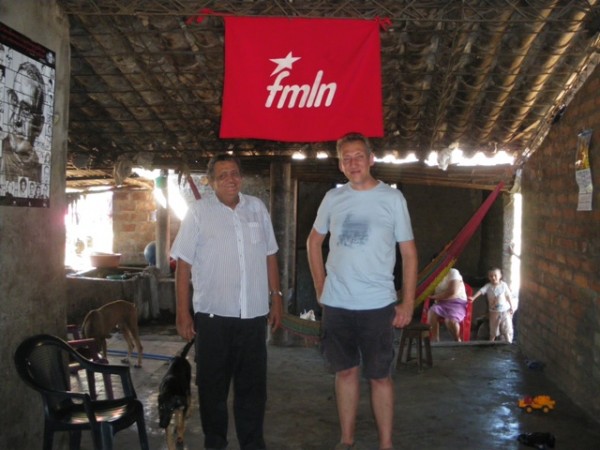
Candelario was a key figure within the Marxist rebel guerrilla forces during the 1980s conflict; the front line ran through this area for much of the civil war. In recent years along with other villagers he has started a tourism initiative that aims to show visitors the old guerrilla hideouts and to share with them the stories of what really happened during those traumatic years. We would hear several times that day about this burning desire to keep the memories of the past alive.
While now well into his fifties Candelario has retained his natural charisma. His softly spoken voice and smiling face contrast with the more typical picture of a guerrilla fighter. While we sat on plastic garden chairs in his unassuming home, barely decorated apart from the picture of Archbishop Romero adorning the grey plastered walls, he told us of the war years. He recalled living in hiding on the mountain, of trying in vain to make peace and of secret meetings with American politicians that took place in the room in which we were sitting. He spoke with hope about the current political changes and of the FMLN, the former rebels who formed a political party that in 2009 won the election and gained power for the first time.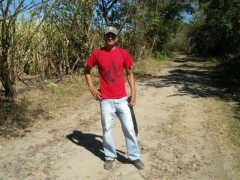
We were then introduced to his nephew Alberto, who would take us on our hike onto the mountain. Armed with his machete, Alberto led the two of us through the lower slopes in the early morning sunshine. Miguel had stayed behind, which left me scrambling with my limited Spanish to decipher Alberto’s vivid recollections and descriptions. While I did get the gist of his stories, not for the first time on this trip I was frustrated at not being more proficient in Spanish.
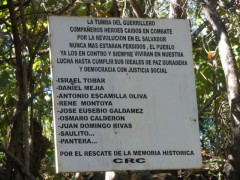 The community had lived in hiding on the slopes of Guazapa during the war years, and many had died during the relentless attacks by US-funded government forces who were determined to eliminate the rebels from this area. Alberto was only a child at the time, but he spoke with raw emotion as he spoke about his mother who was killed here when he was only four years old. Pointing out her graveside, we stood back while he paid his private respects. For him this will clearly always be a sacred mountain.
The community had lived in hiding on the slopes of Guazapa during the war years, and many had died during the relentless attacks by US-funded government forces who were determined to eliminate the rebels from this area. Alberto was only a child at the time, but he spoke with raw emotion as he spoke about his mother who was killed here when he was only four years old. Pointing out her graveside, we stood back while he paid his private respects. For him this will clearly always be a sacred mountain.
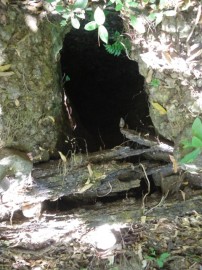 As we climbed, Alberto showed us the ruins of the old school, the church and the cemetery, which was far too full for such a tiny community. He also stopped by and described for us many of the tatus, or hideouts, where people would dive for cover when the planes were dropping their lethal cargo onto Guazapa. Bomb craters were everywhere, and we even saw bullet cases on the path, still there after many years of quiet.
As we climbed, Alberto showed us the ruins of the old school, the church and the cemetery, which was far too full for such a tiny community. He also stopped by and described for us many of the tatus, or hideouts, where people would dive for cover when the planes were dropping their lethal cargo onto Guazapa. Bomb craters were everywhere, and we even saw bullet cases on the path, still there after many years of quiet.
The views from the look-out point at the top were spectacular, and we watched in silence as a pair of large birds of prey circled lazily over our heads, riding the morning thermals that rose from this beautiful hillside.
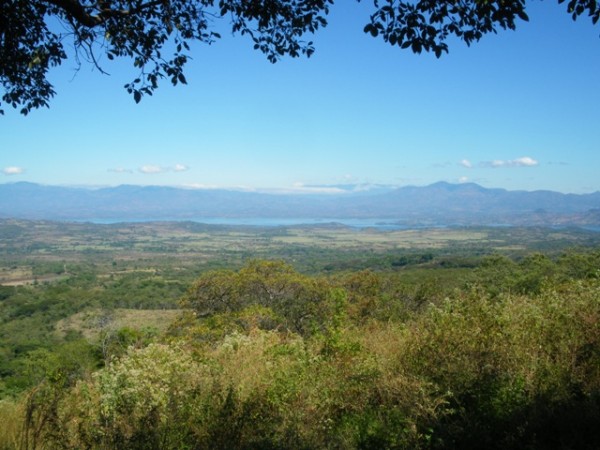 As we slowly made our way back to La Mora in the midday heat, we reflected on the horrors of life as it would have been in that very place a mere 20 years ago. The visit to Guazapa was a sharp contrast to the peaceful natural wonders we had seen elsewhere in El Salvador. Yet it is an essential part of the recent history of this nation and a history whose legacy is still shaping the country today.
As we slowly made our way back to La Mora in the midday heat, we reflected on the horrors of life as it would have been in that very place a mere 20 years ago. The visit to Guazapa was a sharp contrast to the peaceful natural wonders we had seen elsewhere in El Salvador. Yet it is an essential part of the recent history of this nation and a history whose legacy is still shaping the country today.
The cost of the three hour hike was $25 for the two of us ($10 for our guide Alberto and $15 that goes to the La Mora community).





I’m ashamed to admit it Andy, but you probably knew more about the war in El Salvador than anyone in the U.S. did. It’s a BIT better now, but sometimes living in the States is like being in a news blackout. We’re so isolationist that we get precious little international news unless it’s a huge disaster. I’ve been reading of late about the country though, and people are giving it high praise. Hopefully, with coverage like your article they will begin to draw more tourists.
I agree with you, when things are far away from your own country media for some reason don’t see it as important..
I just had a similar experience, visiting the Tuol Sleng Genocide Museum today.
In Europe, few people know about Pol Pot, the war and especially what has happened since.
How fascinating to get an insight into the history of the country from someone who lived through it.
Thanks for the comments, ladies.
Sofia, it’s strange as we visited Guazapa a year to the day after we had visited Tuol Sleng and the killing fields site in Phnom Penh. As you found no doubt, these stories take on a different perspective when you actually see the places at first hand – and especially when you meet the survivors (every one over 40 in Cambodia would have a story to tell although most would be reluctant to share it).
Barbara, as you say El Salvador does deserve better press coverage and I hope these posts can do a tiny job in helping to promote what the country has to offer.
Some of us in the states were aware of the war, but the news was very limited… And sadly many didn’t pay attention to el Salvador or Guatemala… Or most of Central America…
But I am glad to learn of this tour, and there is no better way to learn than from the people who lived it.
Thanks for writing the post.
Stay adventurous, Craig
Thanks Craig for sharing your thoughts. We were very fortunate to be able to meet Don Cande and learn from the man himself much of what went on in those tragic years.
hello, I’m salvadorean and i appreciatte your report Mr. Jarosz. I’m lived the civil wa I was a teenager at that time, but believe or not I’m never been in Guazapa…
thank you for sharing this with the world .
Great story, I currently live in Miami Florida, and I am from el Salvador ,I know about this war because my uncle was a guerilla , as a teen boy, he even has pictures of it. I like this story, and my dad has also told me many stories about the war, about how you’d see massacre everywhere. I dont know where is guazapa, because my people are from la union , oriente, n canton la joya, great story.